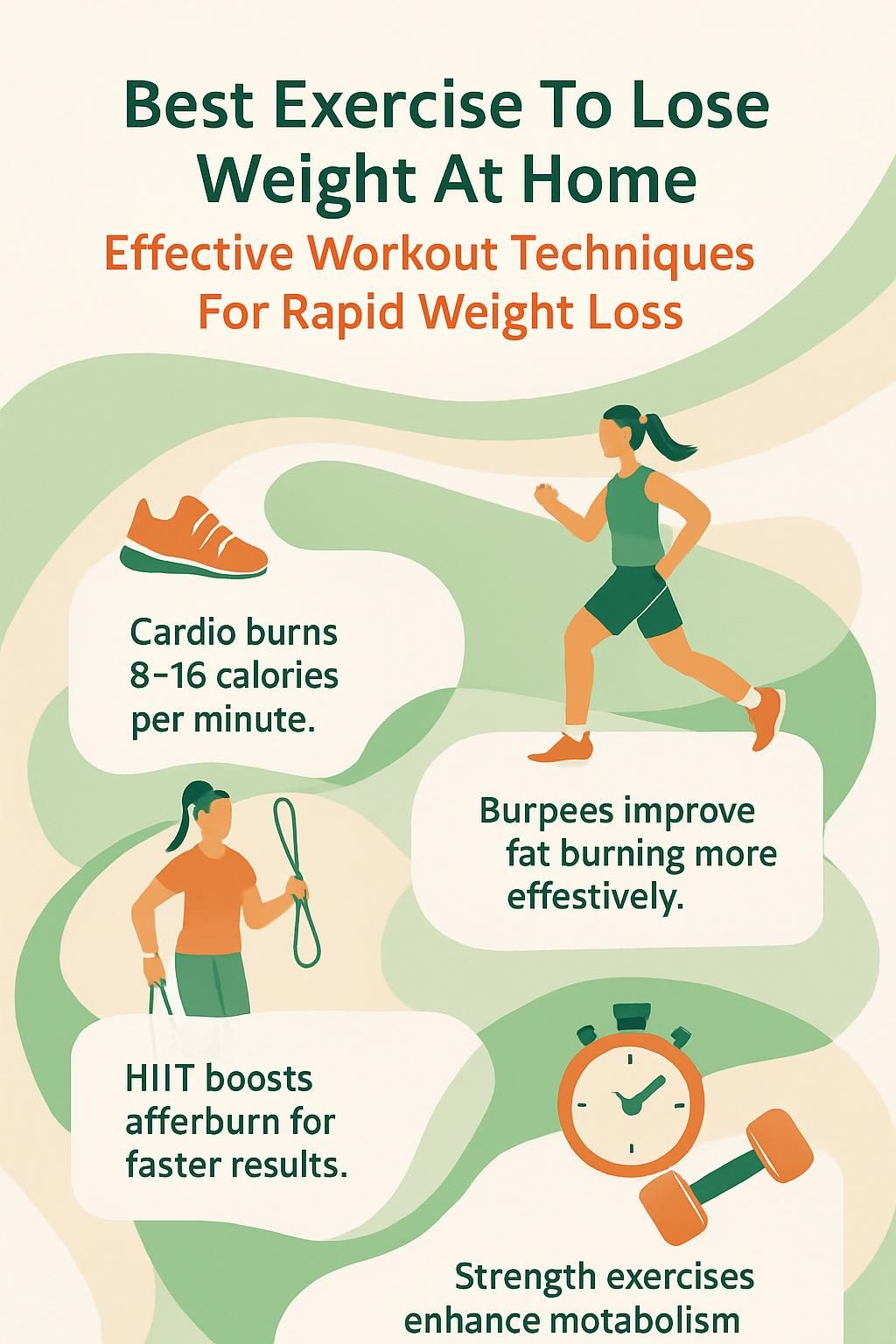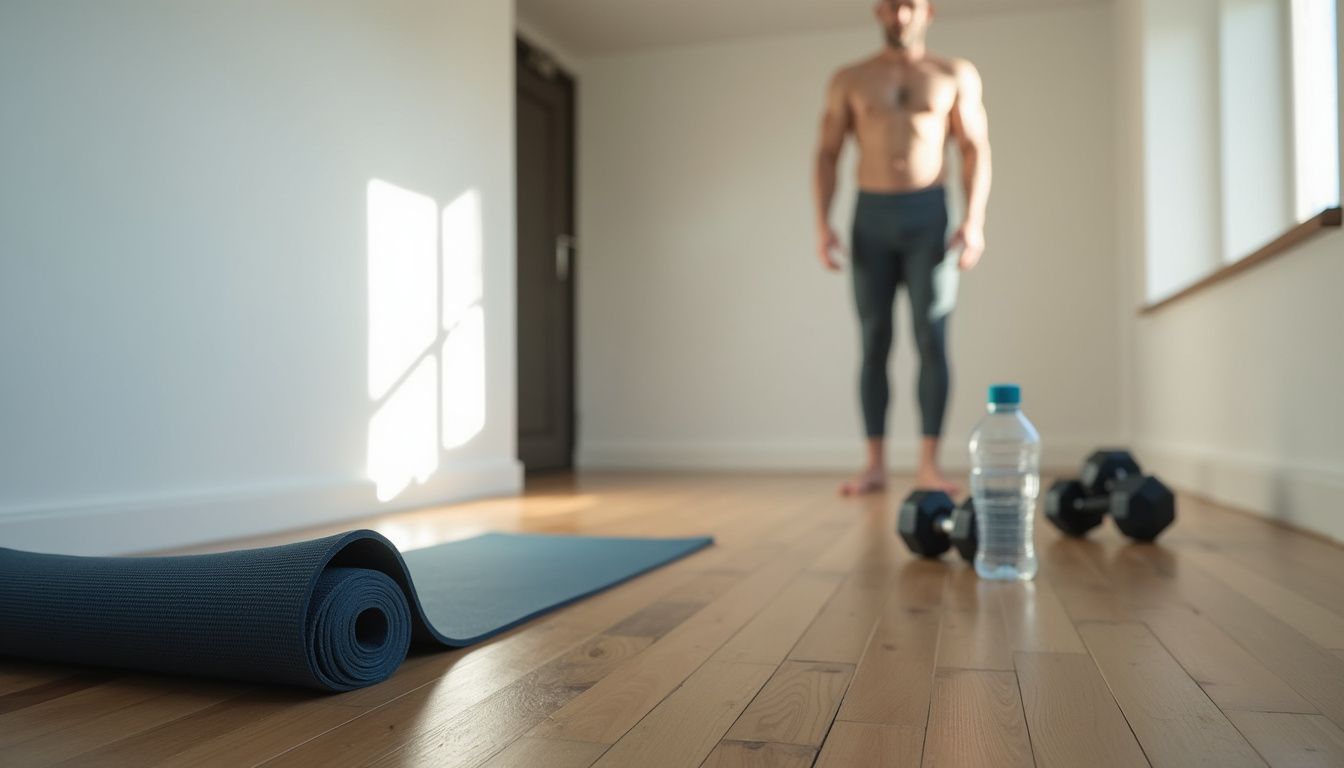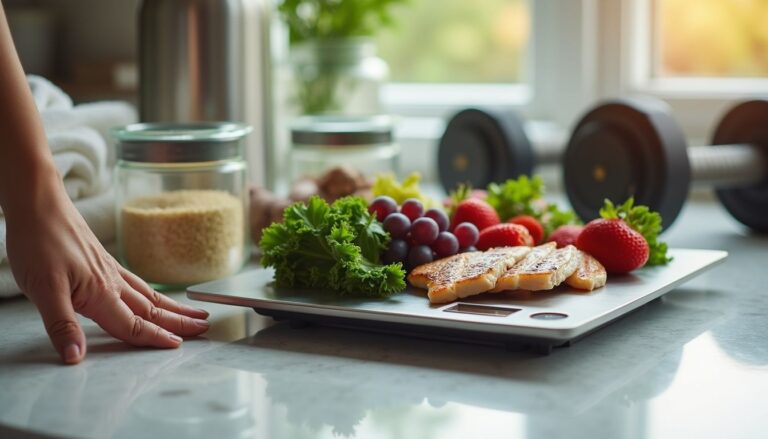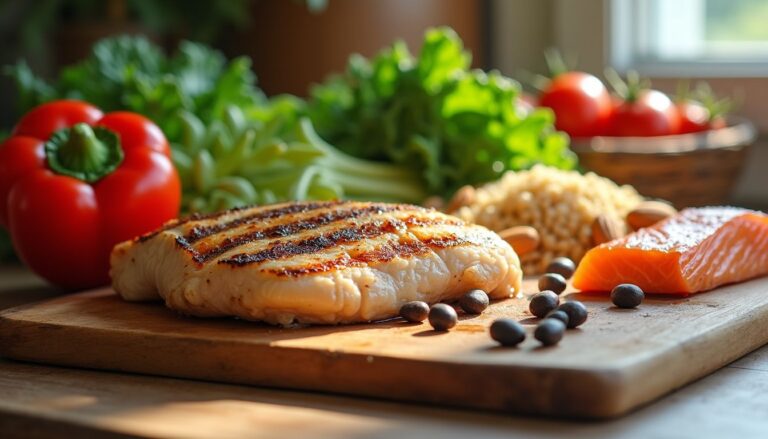Best Exercise To Lose Weight At Home: Effective Workout Techniques For Rapid Weight Loss
Our Nutrition Assistant AI Suite will transform your body. You will lose fat, get toned, and build muscle. Gain confidence and optimal health.
If you feel pressed for time or money for a gym, you are not alone. Research shows that regular at-home exercise helps you lose weight and cut body fat while keeping things simple and low cost. These exercises to lose weight at home give you structure without travel or crowds.
This guide on the best exercise to lose weight at home walks you through cardio, strength training, and fat-burning moves you can do in your living room. You will see how to start, how to progress, and how to keep results going the smart way.
Ready to build an at-home workout that fits real life and brings steady progress? Read on if you want real change without going to the gym.
Key Takeaways
- Home workouts support weight loss and save money. The average gym membership in 2023 cost more than $500 per year, according to IHRSA.
- Cardio like high knees or jump rope can burn about 8 to 16 calories per minute. Consistency plus a calorie deficit helps lower body fat, based on Harvard Health estimates.
- Full-body moves such as burpees and mountain climbers raise heart rate fast. They often burn more fat than steady, slow cardio, which aligns with American Council on Exercise reports.
- High-intensity interval training, including Tabata, can boost the afterburn effect. That means you burn extra calories post workout, as noted by the American College of Sports Medicine.
- Combining strength moves like squats and push-ups with core work such as planks builds muscle. More muscle can raise metabolism, which supports long-term weight control.

Key Advantages of Exercising at Home

Exercising at home gives you control over your routine and your schedule. You can pick the best exercises for weight loss, match intensity to your fitness level, and stay consistent.
Why is exercising at home convenient and accessible?
You can train when it fits your day, without gym hours or travel. Simple moves like walking in place, stair climbs, squats, and push-ups blend into short breaks.
Household items help too. A chair works for step-ups, and filled water bottles add light resistance. A mirror helps you check form, while a towel or foam roller aids recovery after your at-home workout.
Cutting out travel removes a common barrier to consistency, which supports your weight loss goals. At-home sessions make fitness easier to stick with, even on busy days.^1
…
^1 American Council on Exercise (ACE). “Barriers to Exercise: Overcoming Your Obstacles.” Accessed June 2024.
How does exercising at home save money?
At-home exercises for weight loss help you skip membership and trainer fees. Everyday objects, like water bottles, can double as light dumbbells, so you avoid buying lots of gear.
Low-cost tools like a jump rope or resistance bands, usually under $20, can power a full-body routine. Cardio moves such as high knees, stair climbs, and planks are free and effective.
IHRSA reports the average gym membership was more than $45 per month in 2023. That can pass $500 a year, not including fuel or class fees. A mat and a few bands can turn any room into a solid cardio and strength space.
Turning my living room into a workout zone with just a mat, two water bottles, and online videos helped me lose 12 pounds in three months without spending on extra gear.
Training at home also saves on gas and transit costs. Free video workouts can guide you to burn calories while keeping fitness affordable year-round.
How can you customize your home workouts?
Adjust sessions to your goals and your schedule. Change intensity, duration, and exercise type as you build endurance and strength.
If you have equipment, use dumbbells, bands, a mat, or a stability ball. If not, rely on bodyweight staples like squats, lunges, burpees, and push-ups. Mix cardio with strength and flexibility to keep progress moving.
Options include high-intensity interval training for calorie burn, Pilates for core stability, and yoga for mobility. Many people find 30 minute circuits effective. Others rotate muscle groups and follow a structured video plan.
Switching routines weekly can prevent boredom and overuse. This flexible approach supports motivation and fits almost any space or budget.
What makes home workouts more private and comfortable?
Your home gives you privacy that a crowded gym cannot. You can focus on learning form at your own pace and avoid feeling watched.
A 2022 Statista survey found over 40 percent of Americans prefer at-home training for the private environment. You control the setup, music, lighting, and room temperature, which makes workouts more comfortable.
Beginner or shy exercisers often stay more consistent at home. Moving without pressure builds confidence and helps you keep the habit longer.
Warm-Up Exercises to Prepare Your Body
Dynamic warm-ups raise your heart rate and prepare your joints. A good warm-up cuts injury risk and sets up better performance during exercises to lose weight.
How do arm circles warm up your muscles?
Arm circles send blood flow to your shoulders, arms, and upper back. Small to large circles activate the deltoids and triceps, and they gently elevate your heart rate.
This move improves shoulder flexibility and prepares you for push-ups, planks, and pressing. Sports medicine experts often recommend arm circles to build range of motion and reduce strain before resistance work.
Add them to your warm-up to help your upper body feel ready for a full-body workout.
What are the benefits of doing jumping jacks?
Jumping jacks ramp up your heart rate quickly and wake up many muscles at once. They challenge your legs, arms, and core in a simple, rhythmic way.
Hold 1 to 3 pound dumbbells for more intensity if your joints feel fine. Keep knees soft to protect them during landings.
About 10 minutes of steady jacks can burn close to 100 calories, depending on weight and pace. Many people feel more energized after using jacks to kick off a session.
How do butt kicks help prepare your body?
Butt kicks warm your hamstrings and glutes. Lifting your heels to your butt fires your posterior chain, which prepares you for squats, lunges, and running.
This move raises heart rate and improves lower body blood flow. Start with 30 seconds and build up. Butt kicks fit well before both cardio and strength work.
Fitness research shows that brief dynamic drills boost neuromuscular activation and flexibility in under five minutes. That can improve how your muscles perform during the workout.
Effective Cardio Exercises for Weight Loss
Cardio raises your heart rate and helps your body burn more calories during and after the session. Regular cardio supports weight management and strengthens your heart and lungs.
How do high knees burn calories?
High knees drive your heart rate up fast. Lifting each knee toward your waist recruits the core, hip flexors, calves, and thighs. Moving your arms with the rhythm adds an upper body challenge.
Using many muscles at speed requires more oxygen and energy. That boosts calorie burn in less time than slow walking. Jumping-style drills like this can burn around 8 to 10 calories per minute for a 155 pound person.[1]
Include high knees in intervals to target fat loss and improve conditioning. They also improve coordination across your hips, knees, and ankles.
…
References
[1] Harvard Health Publishing: Calories burned in 30 minutes for people of three different weights
https://www.health.harvard.edu/diet-and-weight-loss/calories-burned-in-30-minutes-of-leisure-and-routine-activities
Can jump rope or imaginary jump rope help with weight loss?
Yes. Skipping rope often burns more calories per minute than treadmill walking. If you do not own a rope, mimic the pattern with an imaginary rope and the same arm motion.
Jumping quickly activates the calves, core, and forearms while spiking heart rate. Many people burn 10 to 16 calories per minute, depending on speed and body weight.
A rope is cheap and portable. Blend short intervals into your cardio workout to boost results without large machines.
Why are mountain climbers effective cardio exercises?
Mountain climbers work your shoulders, core, and legs together. Holding a plank while driving knees forward demands oxygen quickly, which raises heart rate.
They burn more calories in less time than slow cycling or basic squats. You only need floor space. Alternate knees to chest while keeping your hips steady to protect your back.
With regular use, many people notice better stamina and less belly fat. Stair climbing is another high return option that requires zero equipment.
How does stair climbing contribute to weight loss?
Climbing stairs uses the calves, glutes, and thighs against gravity. That extra effort increases calorie burn compared with level walking.
Research links daily stair climbs with gradual weight loss and improved heart health. Even a few flights per day can add up over time.
Use home stairs or public steps. Short bursts, like two to five minutes, fit well between meetings or chores.
Full-Body Fat-Burning Exercises
Full-body fat-burning exercises light up multiple muscle groups at once, which helps you burn more calories in less time.
How do burpees help burn fat quickly?
Burpees link a squat, a plank, a push-up, and a jump. This chain activates your core, chest, arms, and legs in one rep, which spikes your heart rate.
Compound moves like burpees often burn more calories than single-muscle drills. Adding a push-up increases upper body demand. Short intervals of burpees can support fat loss better than steady jogging for some people.
Many people see faster results after adding two to three sets per week. Keep form tight to protect your shoulders and lower back.
What are skater jumps and how do they work?
Skater jumps use side-to-side leaps that target the glutes, thighs, and core. You hop from one leg to the other like a speed skater, landing softly and balancing before the next jump.
This lateral move raises heart rate fast and challenges stability. No equipment is needed, just some space. It is a good way to add variety and joint-friendly impact.
Studies from ACE show higher heart rates and strong calorie burn with these dynamic moves.[1]
…
[1] American Council on Exercise (ACE). “Top Cardio Workouts for Calorie Burn.” Accessed 2023.
How do inchworms engage your muscles?
Inchworms start with a forward fold. You walk your hands out to a plank, then walk them back to stand. Your core stabilizes, your shoulders work, and your hamstrings stretch.
This move blends mobility and strength. It hits many of the same muscles used in deadlifts and lunges, with less load on the spine.
Research suggests dynamic stretches paired with strength work improve gains more than static holds alone. Coaches often use inchworms in warm-ups to prime the whole body.1,2
…
1: Schoenfeld BJ, et al., J Strength Cond Res 2016;30(7):1959-1964.
2: National Academy of Sports Medicine (NASM), “Dynamic Stretching Benefits,” 2023.
How does the frogger exercise aid fat loss?
The frogger is a squat thrust with a quick hop. It engages your core, legs, and shoulders while keeping your heart rate high.
Like burpees, it is a compound drill that burns more calories than slow, steady cardio. Many people find it easier on the joints than full burpees.
Use it in short bursts to support fat loss at home. No equipment required.
Strength Training Exercises for Muscle Building
Strength training builds lean muscle, which can raise your resting metabolic rate. More muscle means you burn more calories, even on rest days.
How to do push-ups and modified push-ups correctly?
Start in a plank with hands under shoulders. Keep a straight line from head to heels and brace your core. Lower until elbows reach about 90 degrees, then press back up.
Beginners can place knees on the floor to reduce load. Keep hips level and neck neutral. This builds chest, shoulders, triceps, and core safely.
Progress from knee push-ups to full push-ups as strength improves. Research from ACSM supports gradual progressions to reduce injury risk and build muscle effectively.
What dumbbell or resistance band exercises build muscle?
Use presses, rows, and shoulder presses to train the upper body. For the lower body, add squats and lunges with dumbbells or bands. External resistance increases tension, which drives growth.
For example, a banded row strengthens the mid back and biceps, which improves posture. Studies suggest external load can boost muscle gains compared to bodyweight work alone.
Choose a weight or band that feels challenging for the last few reps. Aim for 8 to 12 reps per set with good form.
How do glute bridges strengthen your lower body?
Glute bridges target the glutes, hamstrings, and lower back. Lifting your hips while squeezing the glutes improves hip stability and posture.
Add a band around the thighs or place a weight on your hips for more challenge. Stronger glutes support squats, lunges, and daily activities like lifting and climbing stairs.
Many people also notice less lower back tightness over time. Train two or three days per week for steady progress.
What are the benefits of squats and squat jumps?
Squats build strength in the quads, hamstrings, and core. The pattern matches daily tasks like sitting and lifting, which helps prevent injury.
Squat jumps add a plyometric boost and raise heart rate quickly. They burn more calories per minute than regular squats. Hold light dumbbells or wear a weight vest if you need more intensity.
Compound moves like squats help maintain muscle while you lose fat. That supports a better body composition over time.
Core Strengthening Exercises
A strong core improves posture, balance, and lifting mechanics. It also supports safe movement during both cardio and strength training.
How to perform plank and side plank for core strength?
For a forearm plank, set elbows under shoulders and keep a straight line from head to heels. Tighten abs, glutes, and lower back. Hold for 20 to 60 seconds without letting hips sag.
For a side plank, stack your feet and support your body on one forearm beneath your shoulder. Lift hips and hold for 15 to 45 seconds per side. These holds build endurance and stability across the trunk.
Strong core muscles help you brace during moves like burpees and mountain climbers.
Why are bicycle crunches effective for your abs?
Bicycle crunches combine a twist with a knee drive. This activates the obliques on the sides of your waist and the front ab muscles at the same time.
They often engage more of the core than standard crunches. Focus on slow, controlled motion and full rotation rather than speed.
Two sets of 15 to 20 reps can be enough to feel a strong stimulus.
How do Russian twists target your obliques?
Russian twists ask you to rotate your torso from side to side while bracing your core. This targets the obliques and improves trunk control.
Hold a weight or a ball to increase difficulty. Keep your spine long and move with control to protect your lower back.
Use them near the end of your session to finish the abs without tiring them before heavy lifts.
What are flutter kicks and how do they help core muscles?
Flutter kicks train the lower abs and hip flexors. Lie on your back, lift your legs a few inches, and make quick, small up and down motions.
Keep your lower back pressed gently toward the floor. Start with 20 to 30 seconds, rest, then repeat. They help build lower core endurance that carries into other exercises.
High-Intensity Interval Training (HIIT) Workouts
HIIT uses short bursts of hard effort, followed by brief rest. It is time efficient, and it helps you burn calories quickly.
What is a Tabata workout and how does it work?
Tabata is a HIIT format that uses 20 seconds of all-out work and 10 seconds of rest, repeated 8 times. The total is four minutes, but the effort is very high.
Studies show Tabata can improve both aerobic fitness, which uses oxygen, and anaerobic fitness, which relies on stored energy. Dr. Izumi Tabata first tested this method in the 1990s.
You can pick moves like burpees, jump squats, or mountain climbers. Many people notice strong results compared with slow, steady cardio.[^1]
…
[^1]: American College of Sports Medicine (2023). “High-Intensity Interval Training: Evidence-Based Applications.
How to combine burpees and jumping jacks in a HIIT session?
Try 30 seconds of burpees, then 30 seconds of jumping jacks. Rest 15 to 20 seconds. Repeat for 4 to 6 rounds.
This pairs a powerful full-body drill with fast cardio. It trains both strength and endurance in a short window. Move quickly, but keep form clean.
Why are sprint intervals good for rapid weight loss?
Sprint intervals ask you to push near your max for short efforts, then recover. This triggers the afterburn effect, which keeps your calorie burn elevated for hours.
One simple setup is 30 seconds fast, then 60 seconds easy. Repeat 6 to 8 times. You can do this on a treadmill, a bike, or outside.
Many people report faster changes in energy and body composition with this style.
How do plank jacks increase workout intensity?
Plank jacks mix core stability with fast leg motion. From a plank, jump your feet wide, then back together while bracing your midsection.
This adds cardio stress to a core hold. Shoulders, abs, and hips all work as your heart rate climbs. Use 20 to 30 second bouts inside a HIIT circuit.
Flexibility and Balance Exercises
Flexibility and balance work keeps joints moving well and reduces injury risk. It also helps you recover between hard days.
How can yoga assist with weight loss?
Yoga blends strength, mobility, and mindful breathing. Regular practice is linked with lower body mass index and better stress control.
Holding poses builds muscle endurance, which supports a higher metabolic rate. Calmer eating habits often follow as stress goes down.
What Pilates movements improve flexibility and balance?
Pilates drills like leg circles, spine stretch, and single-leg stretch target the core while improving alignment. Many routines need only a mat.
Moves such as swan or rolling like a ball teach control through the full range of motion. Short daily sessions can reduce stiffness and improve balance.
Online classes can keep your routine fresh and help you learn safe technique.
Tips for Maximizing Weight Loss Through Home Workouts
Smart habits make your effort pay off. Simple planning and tracking remove guesswork and help you stay consistent.
How to set realistic fitness goals?
Match goals to your current fitness. If you are new, try three 20 minute sessions per week and build up.
Use a log or app to track workouts, reps, and minutes. Small wins, like two more push-ups or an extra interval, add up over time.
ACE and other exercise psychology sources suggest that clear, modest targets improve long-term adherence.
What are the best ways to stay consistent with workouts?
Pick activities you enjoy, like dance cardio or bodyweight circuits. Schedule workouts at the same time most days to build a habit.
An accountability partner helps. People who train with support tend to stay active longer. Put reminders on your phone and lay out your gear in advance.
Why should you pair exercise with a healthy diet?
Exercise works best with a balanced eating plan. Whole foods such as fruits, vegetables, whole grains, and lean proteins fuel training and recovery.
The CDC notes that combining regular activity with a healthy diet leads to more sustainable weight loss than either one alone. Limiting ultra-processed foods helps manage calories and hunger.
Plan simple meals after workouts, like chicken with vegetables and rice, to support recovery and energy.
How to monitor progress and celebrate milestones?
Track date, duration, and intensity for each session. Note how you felt, plus any personal records.
Celebrate milestones with a healthy reward, like new socks or a fresh playlist. Positive reinforcement builds momentum for the next goal.
If you have a medical condition, injury, or are pregnant, talk with a healthcare professional before starting a new plan.
Conclusion
Choosing the best exercise to lose weight at home gives you control and consistency. Combine cardio, strength training, and core work to burn calories and build muscle. Use the talk test to gauge effort. You should be breathing hard but still able to speak a short sentence.
Rotate HIIT, bodyweight moves, and resistance training for balanced progress. Pair your exercise routine with a nutrient-dense diet and steady sleep. If you have health concerns, check with a clinician first.
Small steps add up. Keep showing up, track your wins, and let every home workout move you closer to your goals.
FAQs
1. What is the best exercise to support weight loss and overall health at home?
Aerobic activities such as brisk walking, cycling, or jumping rope help burn calories and improve heart function. Studies show that regular aerobic movement can reduce body fat while supporting cardiovascular wellness.
2. How often should I work out at home for effective weight loss and overall health?
Experts recommend at least 150 minutes of moderate activity each week for adults aiming to lose weight and maintain overall health. This schedule may include five sessions of thirty minutes each, which helps sustain steady progress.
3. Can strength training aid in rapid weight loss and improve overall health?
Yes; resistance exercises like push-ups or squats build muscle mass, increase metabolism, and promote long-term calorie burning. Research indicates that combining strength routines with aerobic workouts leads to greater improvements in both weight loss and general well-being.
4. Are there any simple workout techniques suitable for beginners seeking better weight loss results at home?
Bodyweight movements such as lunges, planks, or step-ups are easy to learn yet effective for those new to fitness routines focused on weight loss and overall health. These exercises require no equipment but deliver measurable benefits when performed regularly.
Summary: Aerobic activity combined with strength training supports efficient calorie use while improving heart function and muscle tone; this approach enhances both rapid fat reduction and lasting wellness according to current evidence-based guidelines on physical activity for optimal results in a home setting.







